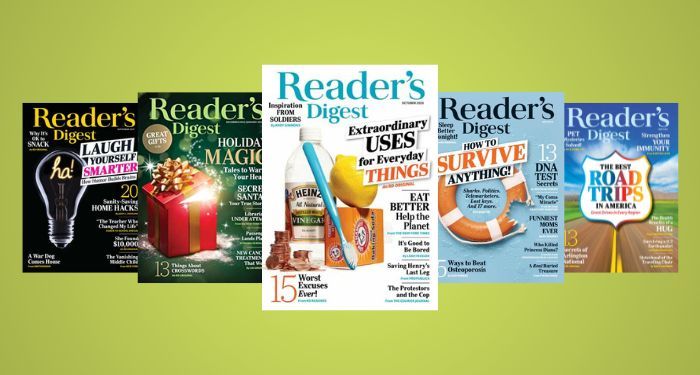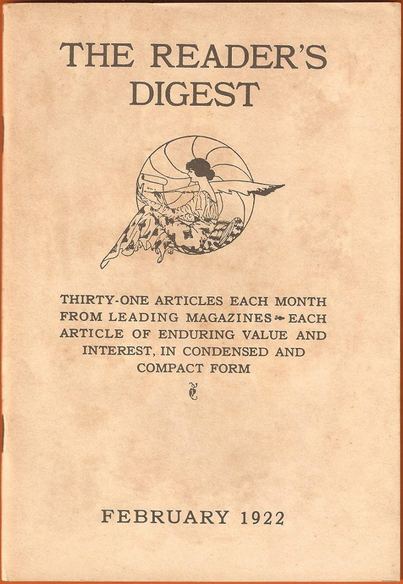
The Storied History of Reader’s Digest
Reader’s Digest is a household name the world over. And I mean that literally: I first stumbled upon a copy in my grandparents’ house in Argentina. I don’t remember which grandparent anymore: both my mom’s parents and my dad’s mother bought the Spanish edition (Selecciones) on a monthly basis. Along with advice columns, these thick magazines were my childhood obsession. Years later, having long since stopped reading them, I was browsing a magazine stand when I noticed how slim Selecciones had become.
The thin volume carried a clear message, I thought. Even without knowing the behind-the-scenes turmoil, I assumed it would soon stop being published altogether. What I didn’t know was the long, eventful history behind Reader’s Digest – and that, contrary to what I thought, it wasn’t done yet.
Precedent
Overwhelm by all the reading material available isn’t a new phenomenon. It wasn’t a new phenomenon when Reader’s Digest was first born, either. The idea to condense various publications into a single volume goes as far back as 1844, when Littell’s Living Age began reprinting periodical articles. Literary Digest also preceded Wallace’s brainchild.

The Beginning
DeWitt Wallace and his wife Lila Acheson launched the first Reader’s Digest issue almost exactly 101 years ago, in February 1922. Wallace had sustained shrapnel wounds while fighting in France in World War I, and during his convalescence he read and condensed multiple popular magazines of the day. He made his prototype issue in 1920: 31 articles in 64 pages. But publishers weren’t interested: 18 of them thought that Reader’s Digest wasn’t commercially promising, especially because Wallace was adamant in refusing illustrations and advertisements.
He then met feminist reformer Lila Acheson, who encouraged him to publish Reader’s Digest on his own. The two married, and with $5000 in advance subscription orders (over $88,000 in today’s currency), they established the Reader’s Digest Association in 1921. Precisely one year later, in January 1922, the first issue of a cultural phenomenon was born.
Wallace and Acheson stuck to the prototype’s format: 64 pages and 31 articles, one per day of the month. It remained text-only, no illustrations or photographs in sight, until 1939, when a drawing appeared on the front cover. It would stay there for three years, until the iconic front-cover table of contents replaced it. The magazine was grounded in socially and politically conservative values, lambasting “labor, big government, and any form of political radicalism, and [giving an] all but open endorsement of the Republican Party.” The Wallace’s commitment to the conservative agenda went so far as to have their staff write like-minded pieces for other publications, so that they could then reprint it in the magazine. They refused letters to the editors, as well.
Another much-criticized element is that the articles selected for reprinting were shortened by as much as three-fourths. It has been questioned how much of the original pieces remained – and how much nuance this eliminated.
The Golden Age
The success of Reader’s Digest was astronomical. By 1930, the initial circulation of 5000 issues had increased to over 200.000; and by 1984, the circulation had reached its maximum height of over 17 million. The domestic circulation, that is: starting with a British edition in 1938, the magazine began an expansion that, at its peak, included 49 foreign editions in 19 languages. Reader’s Digest became “the most widely read periodical on the planet.”
Two of the most consequential moves happened in close succession: in 1933, Reader’s Digest began to include original pieces. In 1934, .the magazine added a condensed book version as a regular feature, eventually leading to the Reader’s Digest Condensed Book Club in 1950. Seven years later, it ran “I Quit Smoking, or Cooper’s Last Stand” by Courtney Ryley Cooper, marking the beginning of an extensive series of articles decrying the dangers of smoking. Their original reporting has often been at the cutting edge of medical and scientific advancements.
Visual changes occurred, too. A growing number of illustrations was included in the magazine in the 1970s and ’80s. In May 1998, the front cover began to sport a photograph in lieu of the habitual table of contents.
In addition, not all changes happened to the magazine itself: many, if not most, took place within the Reader’s Digest Association. Among the most relevant is the founding of the Reader’s Digest Foundation in 1938, which supported various causes, primarily in the fields of education and art. Another major moment was the purchase of Funk and Wagnalls in 1965; this gave the Reader’s Digest Association’s book publishing division further variety in the form of reference volumes. Soon to follow were records, movies, and video sales.
Decline and Rebranding
The Wallaces slowly started to turn over control to senior editors in the ’70s. Without their leadership, especially after DeWitt’s death in 1981 and Lila’s in 1984, Reader’s Digest and the Reader’s Digest Association began a steady decline. By 1998, the company’s stock price had plummeted to $17 (as opposed to $56 only six years before). Increasing competition, a changing demographic, and an inability to adapt to swift technological changes all led to filing for bankruptcy twice in five years (in 2009 and 2013), and going through four CEOs in three years. Fortunately for the company, the last one knew how to turn things back around.
When Bonnie Kitzer took over as CEO in 2014, she set out to overhaul the brand, turning it into “a digital-first, multiplatform media company.” Within three years, the Reader’s Digest Association became Trusted Media Brands, retired its $100 million debt, and built a strong online presence. This has reached that necessary new demographic: as of three years ago, according to Comscore, “1 in 3 of the company’s digital audience is a millennial.”
Not many century-old companies on the brisk of extinction make it to the other side whole. It appears that Reader’s Digest, and Trusted Media Brands, are among that select number.
Interested in more bookish history? We got you.













